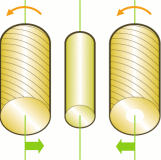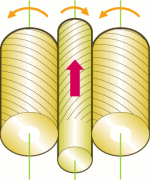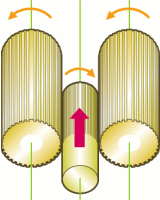NISSEI is Japan's only specialized maker of cylindrical die form rolling machines. Because there are so many applications of cylindrical die form rolling, cylindrical die machines can be used to make a great variety of parts above and beyond the usual threaded kinds.
Parts can be roughly classified, depending on whether two or three dies are used. In general, two-die cylindrical die forming machines have the widest application. Three-die cylindrical roll forming machines are exactly what you need to process thin, tube-like work pieces because the pressure exerted by the dies is dispersed.
In-feed or plunge form rolling puts the work piece between two rotating dies and shapes the work piece by narrowing the distance between the dies. Accuracy and precision are enhanced because pressure is applied to the work piece gently and repeatedly until the final degree of shaping is achieved.

A kind of “walking” effect is utilized, allowing the work piece to follow the shaft direction forward as it is rotated and formed. In order to achieve that forward motion, the main die shafts are set at an inclination. For machines without incline capability, the lead angle of the dies has a compensation angle. Because the work piece moves through while the dies are set at a fixed distance, this process is ideal for long parts such as long threaded parts and long worm gears. This process is only applied to work pieces without flanges and having a lead.

This is a process whereby the work piece is rotated while maintaining a fixed distance between the dies, and the work piece is forced forward in the shaft direction. Force through-feed form rolling machines include a device that pushes the work piece through the rolling dies. Large unit modules featuring spline or serration are typical applications of this kind of form rolling.

Return Top